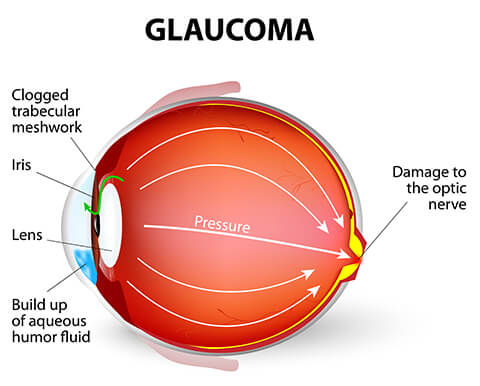
Glaucoma is a disease of the optic nerve – the nerve is part of the eye that carries the images we see to the brain. The optic nerve is made up of many nerve fibers, like an electric cable containing numerous wires. When damage to the optic nerve fibers occurs, blind spots develop. These blind spots usually go undetected until the optic nerve is significantly damaged. If the entire nerve is destroyed, blindness results.
Who is at Risk for Glaucoma?
Glaucoma is the leading cause of blindness in the United States, especially for older people. But loss of sight from glaucoma can often be prevented with early treatment. Early detection and treatment are the keys to preventing optic nerve damage and blindness from glaucoma.
- Age
- Family History
- Race
Your eye doctor will weigh all of these factors before deciding whether you need treatment for glaucoma, or whether you should be monitored closely as a glaucoma suspect. This means your risk of developing glaucoma is higher than normal, and you need to have regular examinations to detect the early signs of damage to the optic nerve.
Glaucoma Treatment Options
If you have recently found out you have glaucoma, it is important to know about all available treatment options. The doctors at Shoreline Vision have vast experience in detecting and treating glaucoma using the latest available technology.
Eye Drops
For patients with glaucoma, eye doctors will usually start by treating glaucoma with eye drops. These eye drops are taken every day and help to lower intraocular pressure. There are several kinds of eye drops available:
- Alpha agonists: Alpha agonists lower eye pressure by reducing how much aqueous fluid the eye produces and increasing the amount of fluid that drains out of the eyes. This is what helps lower intraocular pressure.
- Beta-blockers: Beta-blockers reduce intraocular pressure by reducing the amount of fluid produced by the eye. Reducing the amount of fluid in the eye helps lower pressure in the eye.
- Carbonic anhydrase inhibitors: Carbonic anhydrase inhibitors reduce how much fluid your eye produces, lowering eye pressure. This is not only available as an eye drop but can also be taken by mouth as a pill.
- Miotics: Miotics cause your pupil to get smaller. This increases the amount of fluid that drains from the eye, lowering eye pressure.
- Prostaglandin analogs: Prostaglandin analogs work by increasing how much fluid drains out of the eye, which lowers eye pressure.
It is important to take your glaucoma eye drops exactly as prescribed by your Shoreline Vision eye doctor. Not taking doses daily may result in your intraocular pressure increasing again.
Laser Surgery
For some patients, eye drops may not be enough to lower intraocular pressure. There are two main kinds of laser surgeries performed to treat glaucoma, including:
- Trabeculoplasty: For patients with open-angle glaucoma, a trabeculoplasty is performed to help aqueous drain from the eye. With this procedure, the surgeon uses a laser to help the drainage angle work more efficiently. This allows fluid to flow out of the eye as it should while also reducing intraocular pressure.
- Iridotomy: For patients that have angle-closure glaucoma, iridotomy is a procedure that is available. With an iridotomy, the surgeon uses a laser to create a tiny hole in the iris. By creating a tiny hole in the iris, fluid can flow to the drainage angle and relieve intraocular pressure.
Procedures Performed in an Operating Room
Some traditional procedures that treat glaucoma must be performed in an operating room. These include surgeries like a trabeculectomy.
With a trabeculectomy, the surgeon creates a small incision in the sclera of the eye and covers it with a “trapdoor”. Making the incision, they will also remove a small amount of tissue to help extra aqueous humor fluid inside the eye drain out better. The extra aqueous humor then drains through the trapdoor to a small reservoir hidden right under the surface of the eye. This reservoir is not noticeable since the eyelid hides it.
By allowing the extra aqueous humor to drain through the trapdoor to the reservoir, intraocular pressure gets lowered. You may experience a significant reduction in intraocular pressure after a trabeculectomy, but it is not a cure and you may still experience vision loss after the procedure.
Glaucoma Drainage Devices
If you had a trabeculectomy that was not effective or you have extensive scarring on your eyes from other procedures, your eye doctor may recommend a glaucoma drainage device. This is a tube shunt procedure designed to route any excess fluid from the anterior chamber of the eye to an exterior reservoir.
This is possible because the drainage device uses a silicone tube. The device is a small plate hidden under the upper eyelid. It is then attached to the anterior chamber of the eye with a small silicone tube.
The tube penetrates the eye using a tiny hole in the sclera. Though glaucoma drainage devices are quite good at controlling intraocular pressure, it is not uncommon for patients to still need to use eye drops to maintain their pressure levels.
Looking to treat your glaucoma? Request an appointment at Shoreline Vision at one of our six convenient locations in Fremont, Spring Lake, Grand Haven, North Muskegon, Norton Shores, and Muskegon, MI today.
Request an Appointment
Please note we are seeing patients by appointment only, including optical. Call 231.739.9009
or click here.





